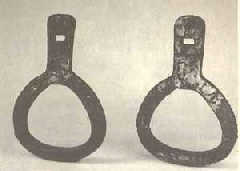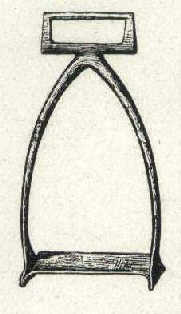The stirrup, despite its small size, is very important, as it makes the rider and horse into one. It greatly increases the rider's ability to control the horse, a feature that in the past made this animal a useful tool in communication, transportation, and warfare.
 Although horses was greatly used in Neolithic and Feudalistic China and even though in theWarring States Period(475-221BC), in theory, many states attached great importance to the use of cavalries (soldiers on horseback), riding a horse was rather difficult since there were still no stirrup. The life-size Terra-cotta warriors and horses of theQin Dynasty(221-206BC) unearthed in Lintong District ofXi'anin Northwest China'sShaanxi Provincerevealed that there were still stirrups at that time though other harnesses were complete.
Although horses was greatly used in Neolithic and Feudalistic China and even though in theWarring States Period(475-221BC), in theory, many states attached great importance to the use of cavalries (soldiers on horseback), riding a horse was rather difficult since there were still no stirrup. The life-size Terra-cotta warriors and horses of theQin Dynasty(221-206BC) unearthed in Lintong District ofXi'anin Northwest China'sShaanxi Provincerevealed that there were still stirrups at that time though other harnesses were complete.
The stirrup is considered one of the basic tools used to create and spread modern civilization. Although many experts believe that the stirrup was invented in North China, it is unclear when exactly it was invented.
It was invented at first as a single mounting stirrup only used in getting into the saddle; the first dependable representation of a rider with paired stirrups is in aJin Dynasty (265-420)tomb of about 322.
The stirrup spread throughout Eurasia by the great horsemen of the central Asian steppes.
Although stirrups reached Scandinavia early, they were first only indirectly documented in Central Europe during the reign of Charles Martel (Charlemagne's grandfather) in the 8th century. A pair of stirrups has been found in an 8th century burial in Holiare, Slovakia.
In the use of the horse in warfare, the stirrup was the third revolutionary step, after the chariot and the mounted horseman. Stirrups changed the basic tactics of mounted warfare and made cavalry more important, especially in Europe. Braced against the stirrups, a knight could deliver a blow with a lance that employed the full weight and momentum of horse and rider together.
Lynn White Jr., in Medieval Technology and Social Change (1966) suggested that the rising feudal class structure of the European Middle Ages derived ultimately from the use of stirrups, saying: "Few inventions have been so simple as the stirrup, but few have had so catalytic an influence on history. The requirements of the new mode of warfare which it made possible found expression in a new form of western European society dominated by an aristocracy of warriors endowed with land so that they might fight in a new and highly specialized way."
Author: Jeff
